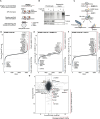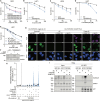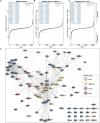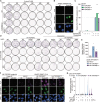Decitabine cytotoxicity is promoted by dCMP deaminase DCTD and mitigated by SUMO-dependent E3 ligase TOPORS
- PMID: 38760575
- PMCID: PMC11183266
- DOI: 10.1038/s44318-024-00108-2
Decitabine cytotoxicity is promoted by dCMP deaminase DCTD and mitigated by SUMO-dependent E3 ligase TOPORS
Abstract
The nucleoside analogue decitabine (or 5-aza-dC) is used to treat several haematological cancers. Upon its triphosphorylation and incorporation into DNA, 5-aza-dC induces covalent DNA methyltransferase 1 DNA-protein crosslinks (DNMT1-DPCs), leading to DNA hypomethylation. However, 5-aza-dC's clinical outcomes vary, and relapse is common. Using genome-scale CRISPR/Cas9 screens, we map factors determining 5-aza-dC sensitivity. Unexpectedly, we find that loss of the dCMP deaminase DCTD causes 5-aza-dC resistance, suggesting that 5-aza-dUMP generation is cytotoxic. Combining results from a subsequent genetic screen in DCTD-deficient cells with the identification of the DNMT1-DPC-proximal proteome, we uncover the ubiquitin and SUMO1 E3 ligase, TOPORS, as a new DPC repair factor. TOPORS is recruited to SUMOylated DNMT1-DPCs and promotes their degradation. Our study suggests that 5-aza-dC-induced DPCs cause cytotoxicity when DPC repair is compromised, while cytotoxicity in wild-type cells arises from perturbed nucleotide metabolism, potentially laying the foundations for future identification of predictive biomarkers for decitabine treatment.
Keywords: DNA–Protein Crosslinks; Genome Stability; Hypomethylating Agents; Nucleotide Metabolism; SUMO-targeted Ubiquitylation.
© 2024. The Author(s).
Conflict of interest statement
The authors declare no competing interests.
Figures











References
-
- Almqvist H, Axelsson H, Jafari R, Dan C, Mateus A, Haraldsson M, Larsson A, Martinez Molina D, Artursson P, Lundbäck T, et al. CETSA screening identifies known and novel thymidylate synthase inhibitors and slow intracellular activation of 5-fluorouracil. Nat Commun. 2016;7:11040. doi: 10.1038/ncomms11040. - DOI - PMC - PubMed
MeSH terms
Substances
Grants and funding
- 855741/EC | ERC | HORIZON EUROPE European Research Council (ERC)
- BE 5342/3-1/Deutsche Forschungsgemeinschaft (DFG)
- YIP4644/The Vallee Foundation
- ASP-II-4555793532/Mark Foundation For Cancer Research (The Mark Foundation for Cancer Research)
- 18796/CRUK_/Cancer Research UK/United Kingdom
- 393547839/Deutsche Forschungsgemeinschaft (DFG)
- DRCPGM\100005/Cancer Research UK (CRUK)
- 801750/EC | European Research Council (ERC)
- 213249687/Deutsche Forschungsgemeinschaft (DFG)
- C6/A18796/Cancer Research UK (CRUK)
- YIP4644/European Molecular Biology Organization (EMBO)
- 29580/Cancer Research UK (CRUK)
- 464588647/Deutsche Forschungsgemeinschaft (DFG)
LinkOut - more resources
Full Text Sources

